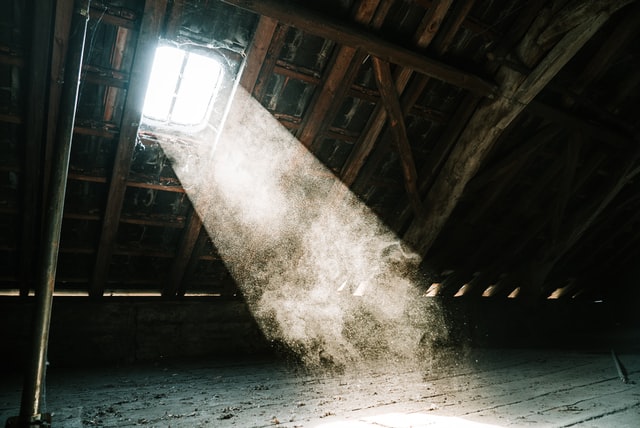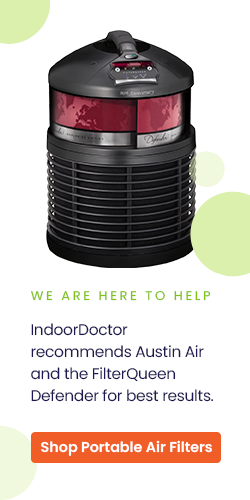Often overlooked by our clients is their sensitivity to dust mites. Typically people sensitive to other indoor pollutants and allergens like molds are very susceptible to the allergic affects of dust mites. Generally people assume that “dust mites are everywhere” and “there’s not much you can do about them.” What we have found through thousands of indoor air quality investigations is that only through sampling can you confirm the presence of dust mite allergens. In a lot of situations people thought their mattress or carpeting contained high dust mite counts when in fact no significant concentrations were detected. Conversely, people who thought their bedding was dust mite proof or their carpeting was clean learned that they did in fact have high dust mite concentrations in their home.
There are many substances in household dust which can cause allergies in humans. The most common allergenic components of house dust, however, are from house dust mites. House dust mites are tiny creatures related to ticks, chiggers, and spiders, that live in close association with humans. Their primary food is dander (skin scales) shed from human and pet activity. Most homes in the United States probably have detectable levels of house dust mites and their allergy-producing fragments.
House dust mites are not parasitic nor are they capable of biting or stinging humans. Their significance as pests is due to the powerful allergens contained in the mites, their cast skins, fecal material and secretions. Symptoms of a house dust mite allergy include stuffy or runny nose, sneezing, coughing or watery eyes. Inhalation of dust mite allergens by hypersensitive individuals can result in acute attacks of bronchial asthma, accompanied by wheezing, and shortness of breath. Diagnostic tests and clinical studies by allergists have shown house dust mite to be the most common allergy in asthmatics, and an important “root cause” for the development of asthma in young children. Recent studies suggest that at least 45 percent of young people with asthma are allergic to house dust mites. Unlike “seasonal” allergies caused by molds and pollen, people who are allergic to dust mites often will have symptoms year round.
House dust mites are tiny adults are about 0.5 mm long and the immatures are even smaller. Consequently, they generally are visible only with the aid of a microscope. The mites are globular in shape, clear to creamy white in color, with hairs on their legs and body. There are two common species in the United States, the North American house dust mite, Dermatophagoides farina (Der f), and the European house dust mite, D. pteronyssinus (Der p).
Der f1 is a thiol protease that hydrolyzes proteins, with a preference for Phe or basic residues. Der f1 is a C1 peptidase family member. Der F1 has extensive endopeptidase specificity. Der f1 causes an allergic reaction in humans. Common symptoms of mite allergy are bronchial asthma, allergic rhinitis and conjunctivitis.
Der p1 is considered a major allergen because of the large number of people sensitive to it, or ‘specifically’ allergic to its harmful content. Der p1 is an active digestive enzyme that can cause cell death in the lungs by ‘melting’ the glue like substance that binds cells together. The cell’s death in turn gives Der p1 access to the body and blood stream. This invasion is how traces of the mite’s major allergen have been found in the amniotic fluid surrounding unborn children. Der p1 is a glycoprotein with sequence homology and thiol protease function similar to the enzymes papain, actinidin, bromelain and cathepsins B and H.
At IndoorDoctor, we use the quantitative Enzyme-Linked ImmunoSorbent Assay (ELISA) analysis for a combination of Dust Mite (Der p1, Der f1) and collect the specimins with a Sterile vacuum dust cassette.
Food is seldom a problem for house dust mites. Their primary food is skin scales (dander) contained in house dust. People and pets regularly shed small flakes of skin from their bodies as the skin continually renews itself. Since the greatest fallout occurs in areas of human and pet activity, the mites tend to be most numerous in beds, overstuffed sofas and chairs, and adjacent carpeted areas. Relative humidity also tends to be higher in these areas, because people perspire and exhale water vapor where they sleep and lounge. Mattresses, sofas, carpet, and other soft furnishings trap and accumulate dust, dander, and moisture, making them ideal microhabitats for mite development
There are two basic approaches to managing dust mite allergy: 1) treatment of the patient, and 2) modification of the patients’ environment to minimize exposure to the mites. An allergist may prescribe quick-relief medications and/or allergy vaccinations (immunotherapy). Immunotherapy involves injecting gradually-increasing concentrations of mite extracts over time in order to desensitize the affected individual.
The second approach often done in conjunction with patient therapy is to minimize exposure to the mites and their allergenic materials inside the home. This is not a simple process and usually requires significant effort and expense. Dust mite abatement has become a huge industry, with companies offering many products and services to allergy sufferers seeking relief from their symptoms. While some abatement measures are helpful, others are relatively ineffective or as yet unproven. Of the treatment measures discussed below, numbers 1-3 are generally considered most essential and effective, whereas the others may provide some secondary benefit.
To reduce the dust mite concentration in the home:
1) Remove or modify furnishings that accumulate dust and provide habitat for dust mites. Carpeting, upholstered furniture, drapes, curtains, stuffed toys, and other fabric-covered furnishings should be replaced with easy-to-clean items. This is especially important in bedrooms and other areas where allergy sufferers spend most of their time. Carpet is a perfect breeding ground for dust mites. If carpeting must be used, select low pile varieties. Area rugs are easier to clean than wall-to-wall carpeting. Hardwood, tile or linoleum floors are much easier to keep clean and dust-free. The same is true of wooden, leather or plastic-covered sofas and chairs. Do not allow children with dust allergies to sleep or play with stuffed, furry toys.
2) Encase mattress, box springs, and pillows in allergen-impermeable covers. Bedding is an extremely important source for dust mite development. Plastic or vinyl covers that zip around mattresses, box springs and pillows seal in allergenic materials so that they are not inhaled while sleeping. They are also easier to keep clean than cotton-based materials. Various styles of dust-proof bedding protectors are available through mattress and allergy supply stores. Many are equipped with an outer layer of material, such as nylon, to enhance comfort. Ideally, it’s best to install dust-proof protectors on new bedding items rather than those that are already laden with allergens.
3) Using “non-allergenic” pillows is not a substitute for covering them with allergy-proof encasements; non-allergenic simply means that the materials are synthetic. Moreover, the evidence is contradictory as to whether foam pillows are any less prone to dust mite allergens than are feather pillows. Use only washable bed spreads, sheets and blankets, and launder bedding weekly in hot water.
4) Attempt to lower relative humidity inside the home. House dust mites have a difficult time surviving when the relative humidity is below 50 percent. Improving ventilation and installing a dehumidifier can often help to reduce populations indoors. Since fabric-covered surfaces retain air and body moisture better than less porous materials (e.g., wood, vinyl, linoleum), removal or modification of carpets, bedding, overstuffed furniture, etc. will further help to reduce humidity and favorable habitat for dust mite development.
5) Maintain good levels of sanitation and housecleaning. Vacuuming and cleaning activities have not shown much benefit in reducing mite populations, or removing their allergenic materials (feces, cast skins, carcasses). Routine, thorough vacuuming can, however, help to remove dust, dander, and a small percentage of mites. When vacuuming is performed, it’s important to use a vacuum cleaner equipped with a HEPA (High Efficiency Particulate Arrestor) filtration system, so that the microscopic allergens are retained within the vacuum bag. Vacuum cleaners lacking this level of filtration will simply re-circulate the tiny allergenic particles back into the air, often causing even greater allergy symptoms. Emphasis should be on bedrooms, mattresses, and other locations where dust mites are likely to be living. Ideally, allergic individuals should not be the ones doing the vacuuming, nor should they be around when vacuuming is being performed. If this is not possible, they should wear a filtered breathing mask. Dusting of surfaces should be done with a damp or oiled cloth.
6) Consider the use of allergen-trapping air filters. Microscopic dust mite particles (especially feces) can remain suspended in the air for hours and be inhaled. To help remove these allergens, HEPA-grade filters can be installed in the central air conditioning and heating system of the home. HEPA filters can also be used within portable air cleaners, placed in bedrooms and other critical areas of the house.






